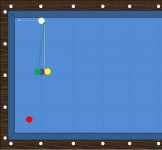Please also check my question about where the stick must line up for the shot with left english. I believe the diagram is wrong on that point as well.
All is correct, BOB!
Bill Smith "Mr3Cushion"
Please also check my question about where the stick must line up for the shot with left english. I believe the diagram is wrong on that point as well.
All is correct, BOB!
Bill Smith "Mr3Cushion"
I am really sorry if I have caused trouble and controversy. I wished to back up my standing on this matter and I believe I have taken it too far. As I have said earlier, what I can do on paper I cannot do nor show in real life, so I suppose I have not proved anything at all. If you would all allow, I take back any argument I have made and will keep it to myself. I am NOT a good player, technical or otherwise. I have spoken out of turn and I sincerely apologize for it and the problems it caused.
In that case, on the table I play on, I think the shot with left english can only be made by hitting rail first or with a half masse.
I am really sorry if I have caused trouble and controversy. I wished to back up my standing on this matter and I believe I have taken it too far. As I have said earlier, what I can do on paper I cannot do nor show in real life, so I suppose I have not proved anything at all. If you would all allow, I take back any argument I have made and will keep it to myself. I am NOT a good player, technical or otherwise. I have spoken out of turn and I sincerely apologize for it and the problems it caused.
No don't shut up or keep it to yourself. Your points make people think. Made you think too. Made me think.I am really sorry if I have caused trouble and controversy. I wished to back up my standing on this matter and I believe I have taken it too far. As I have said earlier, what I can do on paper I cannot do nor show in real life, so I suppose I have not proved anything at all. If you would all allow, I take back any argument I have made and will keep it to myself. I am NOT a good player, technical or otherwise. I have spoken out of turn and I sincerely apologize for it and the problems it caused.
Bill
I tried both shots.
Made the first example on the first try and am getting very consistent. The short bridge works very well and I thank you.
The second shot.....not yet. This is NOT the first shot that others make that I cannot. I will keep at it.
Thanks
Rick
Was the white ball on the first diamond and your cue ball somewhat closer to the end rail than the white ball? About how much did you have to elevate?Well I finally made it and eventually made 2 in a row. I have to elevate my back hand and make a perfect hit. Not a shot I would have thought of. Thanks
Rick

I am SHOCKED SHOCKED SHOCKED, as with many others, to find out that the contact time bwt cuetip and cueball is soooo short in milisecond.... and the videos are the proof. For fast cuetip speed, it must be true... For SLOW cuetip speed, contact time is a tiny bit longer that it might create certain effects on the cueball..
All techniques done, hand movements, different types of stroke use in billiard is to CREATE THE DESIRED ACCELERATION. The outcome of the shot depend largely on many other factors..
I agree with Scott that, "the Shortening and Lengthening of the follow through is a result of the action took place earlier from the stroke". A slow stroke usually follow by a short follow through, while a fast stroke follow with a longer natural follow through.
CONSIDER THIS?
1. With the diagram given by Mr3Cushion, can anyone demonstrate it with all FIVE different types of STROKES said on the first page???
2. Can someone demonstrate a DEAD-BALL STROKE in a five railer shot with 1/3 ball hit, 4 tips of english with fast speed???
In pool, there is a STOP SHOT, where after pocketing the object ball, the cueball stay close to where it made contact with the object ball... NO ONE CALL IT A STOP STROKE OR DEAD STROKE... IT'S JUST A SHOT ITSELF.
It all depends on the speed, cuetip position on the cueball and how thick you hit the object ball..
This thread is getting very interesting and im starting to DOUBT IF THERE ARE REALLY DIFFERENT TYPES OF STROKES???????
Maybe we should call it with DIFFERENT TYPES OF SHOTS rather than DIFFERENT TYPES OF STROKES.......